While making Ranfurly our basecamp for a few days, we took the opportunity to explore the Macraes Historic Mine approximately 56km away. We didn’t get the opportunity last time we stayed in the area (click here to read my Waipiata blog) so it was time to tick it off the list.
Getting There
Following the guidelines from fellow campers that visited the mine site the day before, we set off in search of Golden Point Road. BEWARE – there are actually two Golden Point Roads. We duly turned down the road we thought was the correct one and came across the STOP/GO gateway. This is to allow the HUGE dump trucks to come and go from the present day Macraes mine site.
We mentioned to the staff member at the gate that we were wanting to visit the reserve. She waved us through and onward and upward we went.
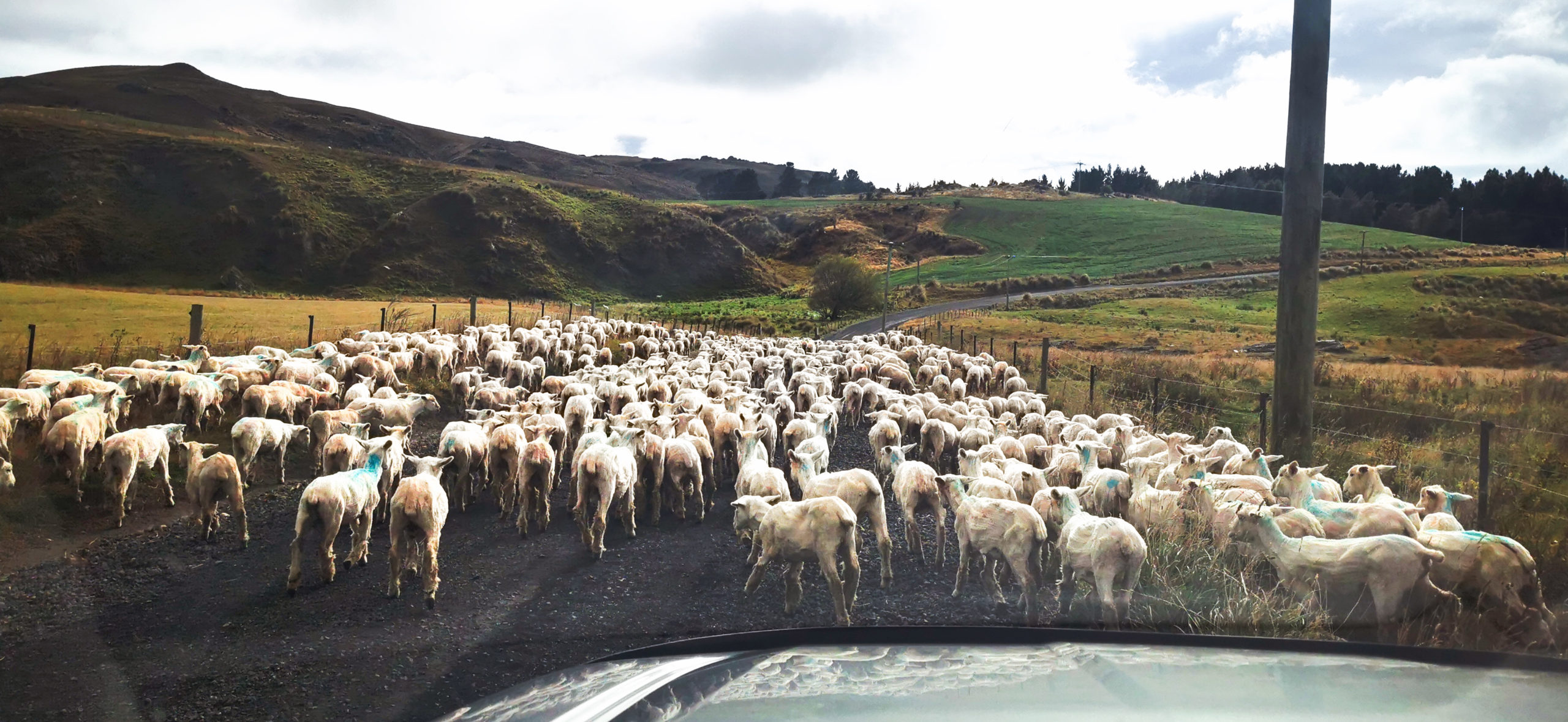
we had to share the road with some woolly friends on our way to the ‘wrong road‘
There were a few gates to open and close – strange that we didn’t recall any mention of gates on our discussions the day before.
Well, the road got narrower, steeper and muddier. Soon Scotty was needing to engage the 4×4. We both got that feeling that ‘something wasn’t quite right.’
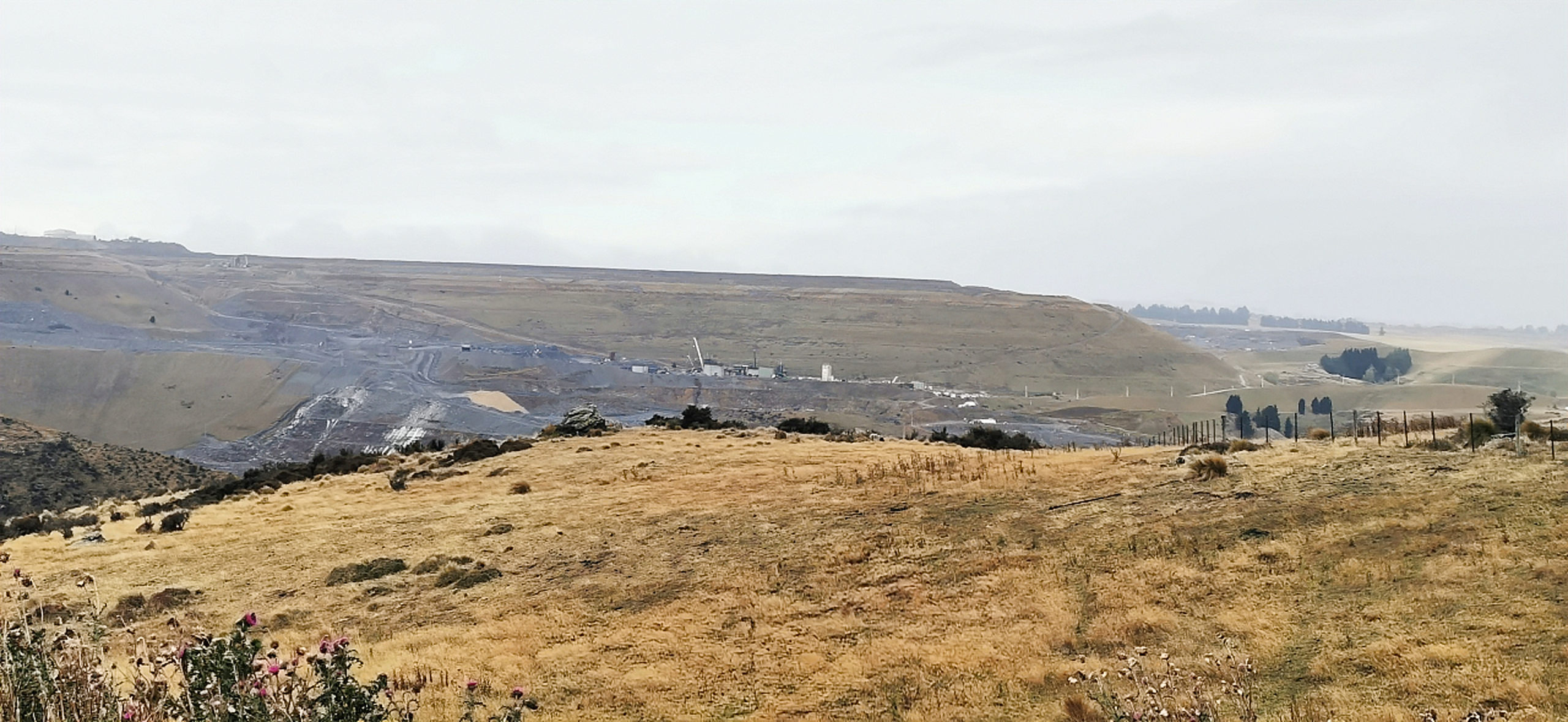
we could see the modern mining activity way in the distance as we traversed the ‘wrong road‘
About Turn
After conducting an 8 point turn we proceeded back to the STOP/GO gates and asked the staff member “we can’t find the old stamper battery”. “Oh,” she said, “you’ll need to proceed back to the main road, travel towards Macraes Flat, past the pub and take the OTHER Golden Point Road”.
We eventually found the correct entry into the Golden Point Historic Reserve, locating the historic site. Although the road down is a little rough and gravel, it is way more manageable than the first route we took!
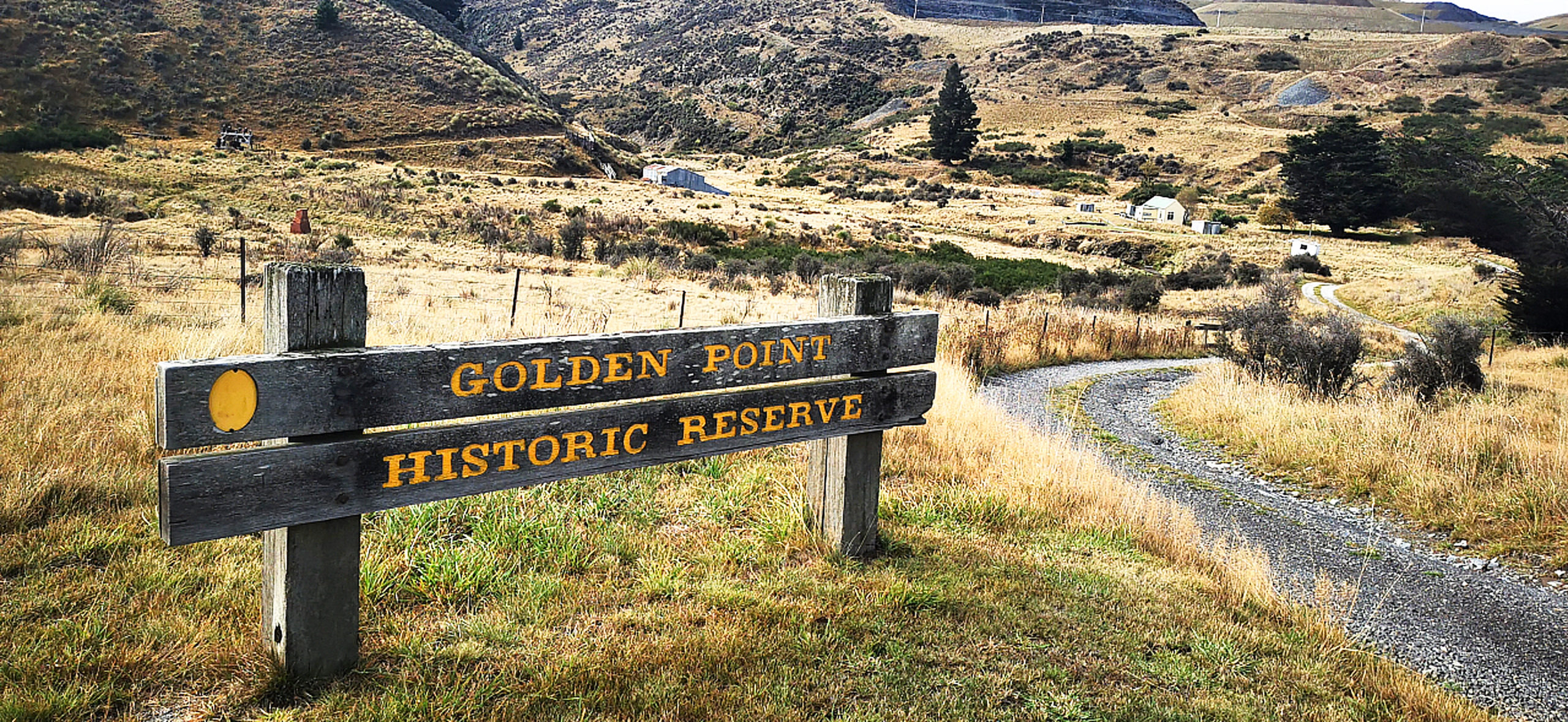
it was a relief to arrive at the Golden Point Historic Reserve
Macraes Mine – Present
OceanaGold Corporation owns the present-day Macraes Mine. It is NZ’s largest active gold-producing mine. It consists of a large scale open-cast mine which opened in 1990. There is also a newer underground mine (Fraser’s Mine) which opened in 2008.
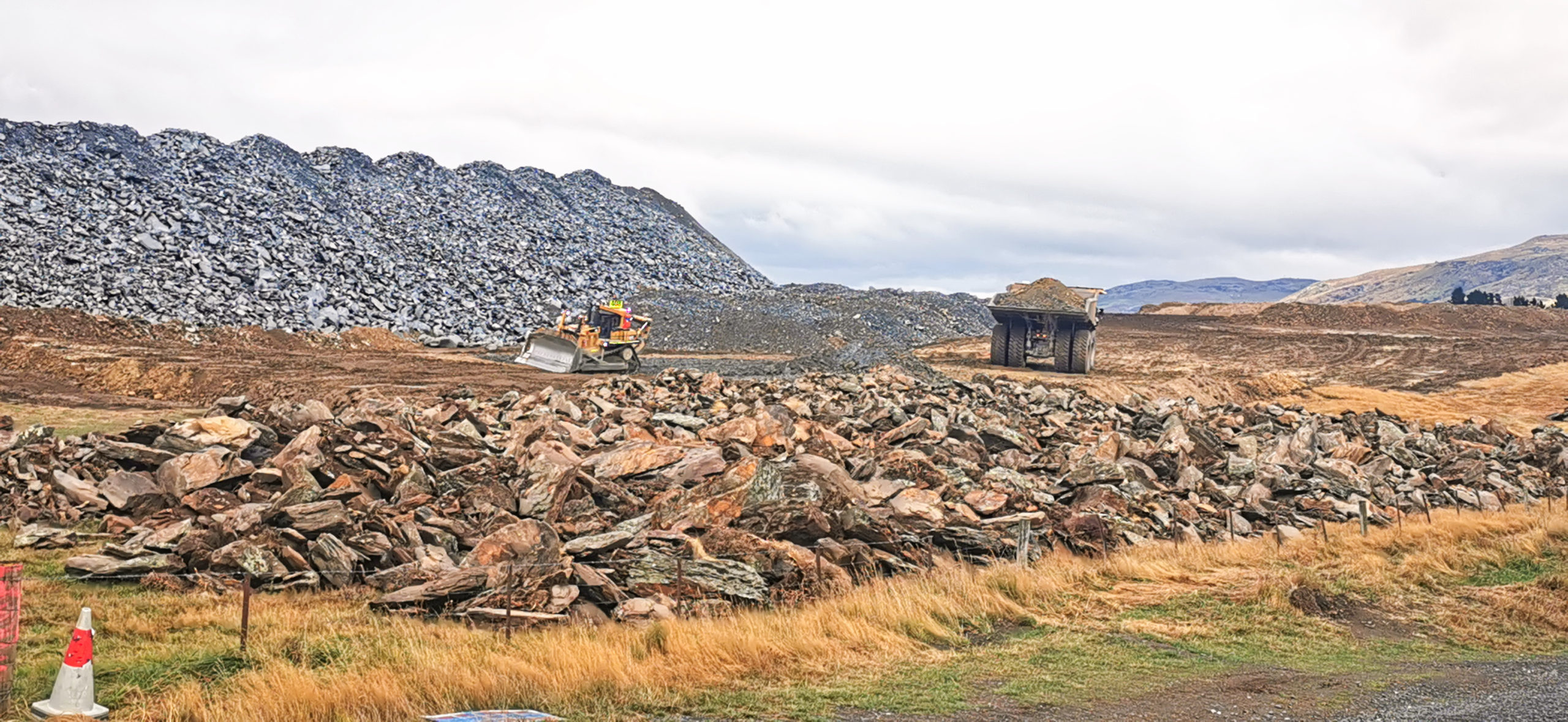
we managed to get up close to some of the massive machinery working the open cast mine – if only some of those old miners could see them moving tons of rubble in one swoop
It has produced more than a massive 5 million ounces of gold since its opening.
It provides the area with gainful employment with over 600 staff working both at the Macraes Mine site and their offices in Dunedin.
Macraes Mine – Future
Nobody can quite predict the future for both the underground and open-cast mines. When mining first started, it was predicted to have a life expectancy of no more than 7 years. Well, that was 31 years ago.
Consents have been granted to extend the life of the mine to 2028 and Frasers to 2022.
Macraes Mine – Past
To be honest, it is often the history that attracts us to visit places.
Gold was first discovered at Macraes Flat in 1862 setting a gold rush in motion. Alluvial gold deposits were found in Deepdell Creek. Back then, shovels, pans, cradles and sluice boxes were used to extract the gold.
The Dwellings
Dotted around the Golden Point Reserve are 3 sod huts and the wooden Callery Cottage on the flat (Mine Manager’s House).
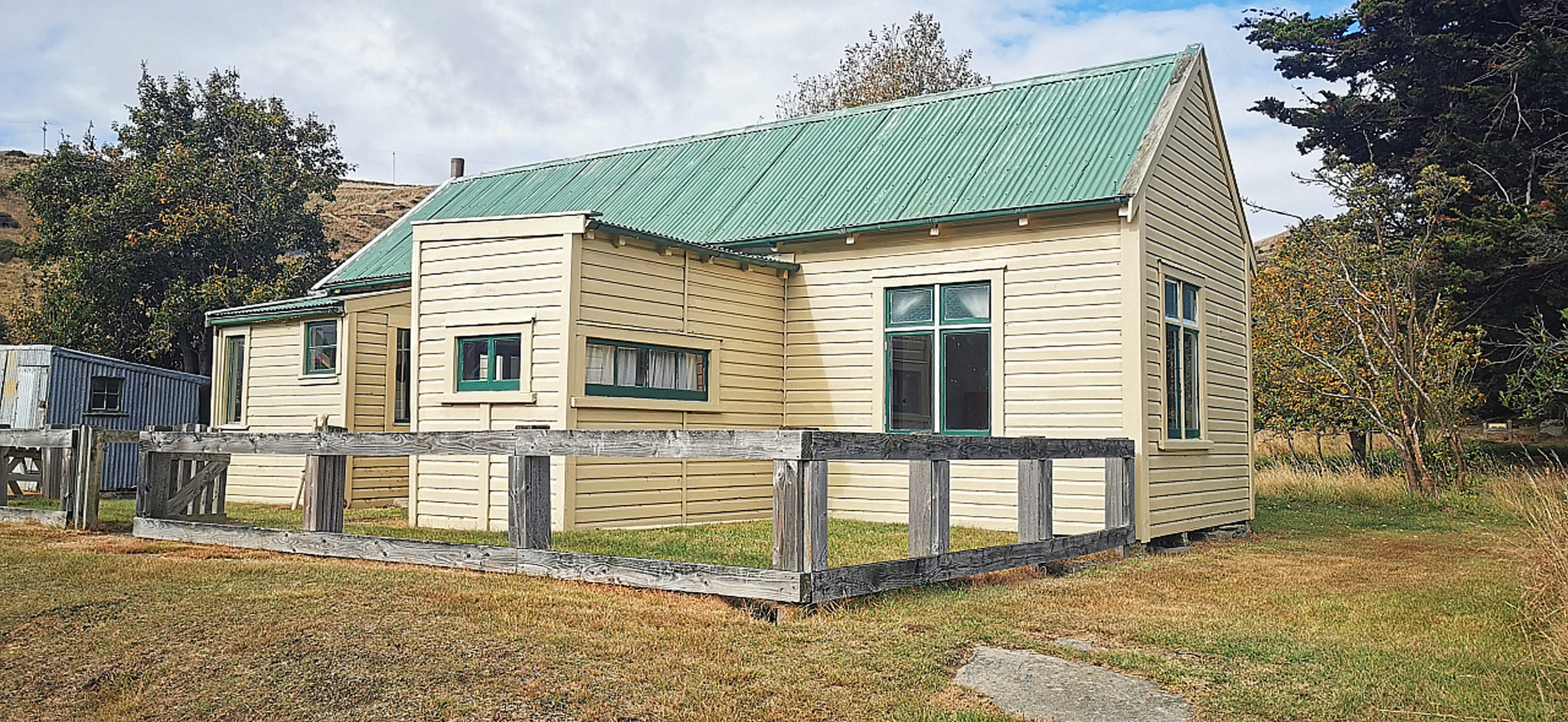
The Mine Manager’s cottage is in good condition and well maintained
The alluvial miners of the 1860s included Chinese miners who lived in tents and rock shelters. It was desperately cold in winter with snow up to 150m above Golden Point.
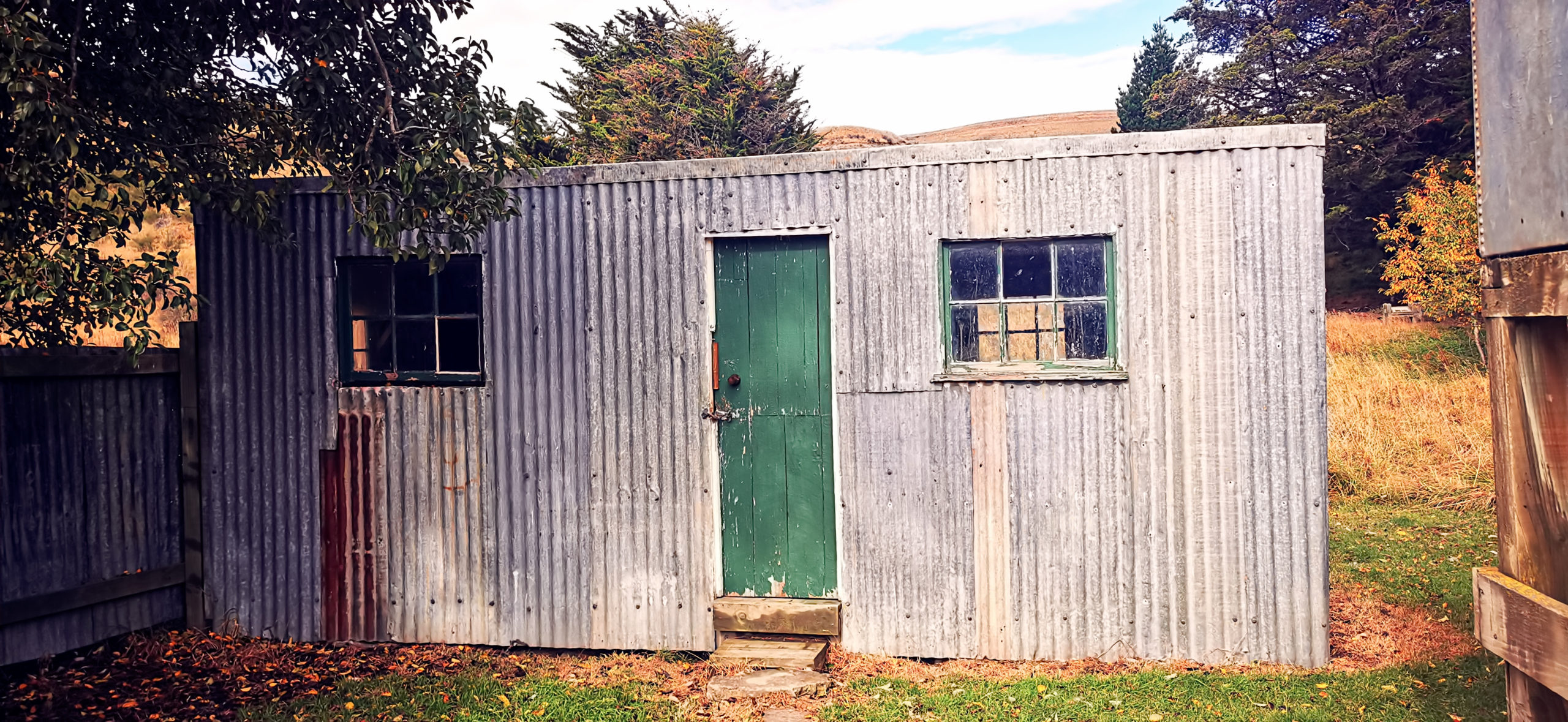
the tin shed out the back of the cottage has seen better days
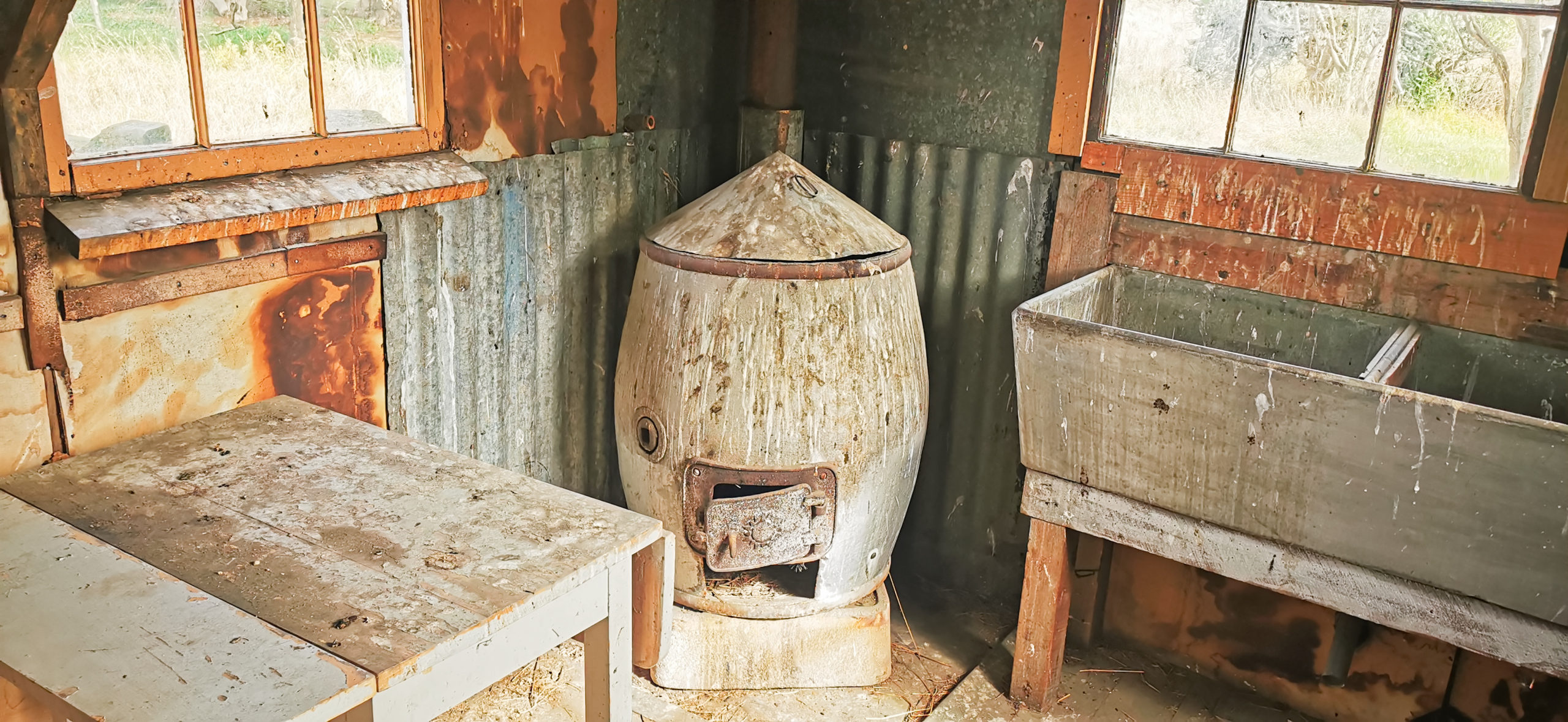
it would have served some of the miners well who had to live in the barren and cold climate
The surviving sod huts date from the late 1920s. The sod bricks were cut from the ground close to the building site. The bricks were then stacked and plastered with wet mud.
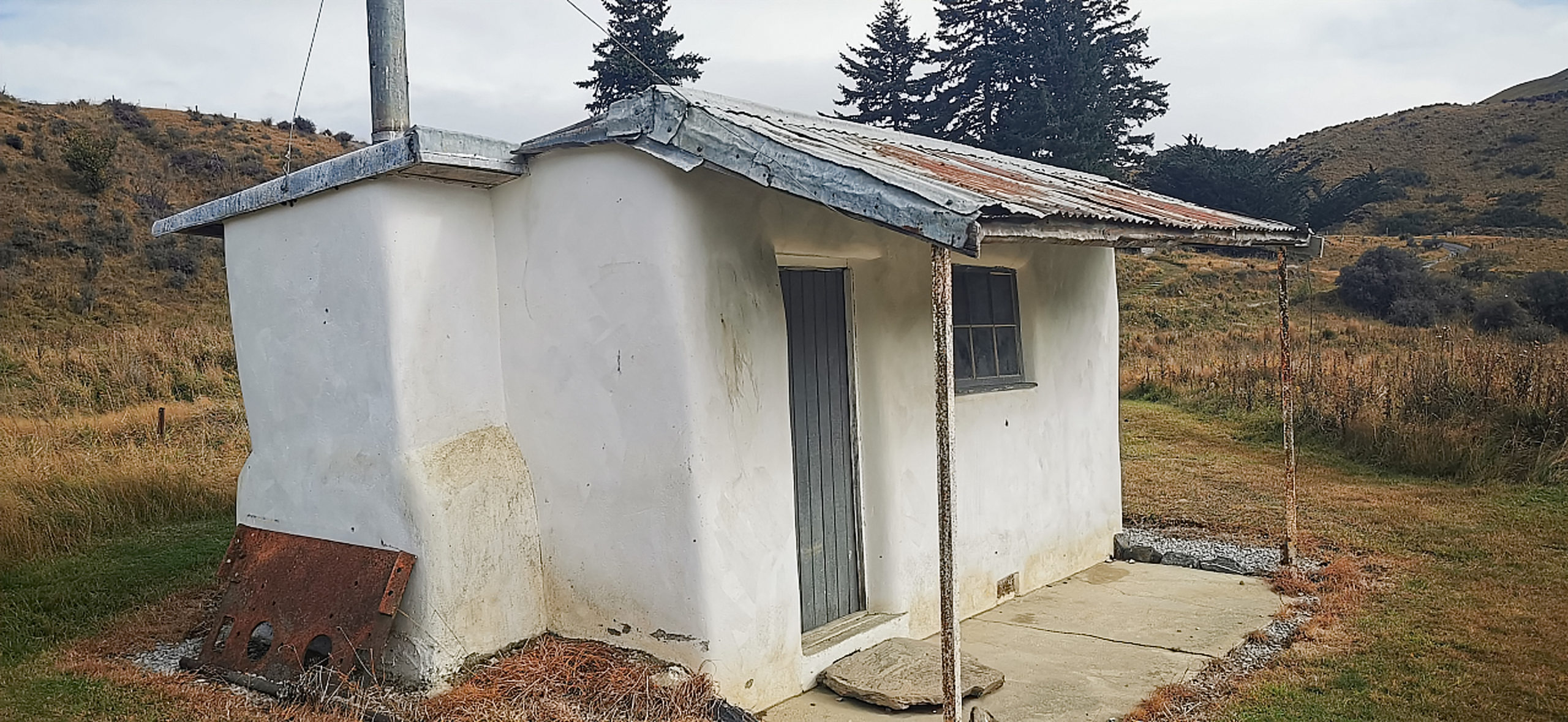
the sod cottage kept the owners warm and safe from the weather
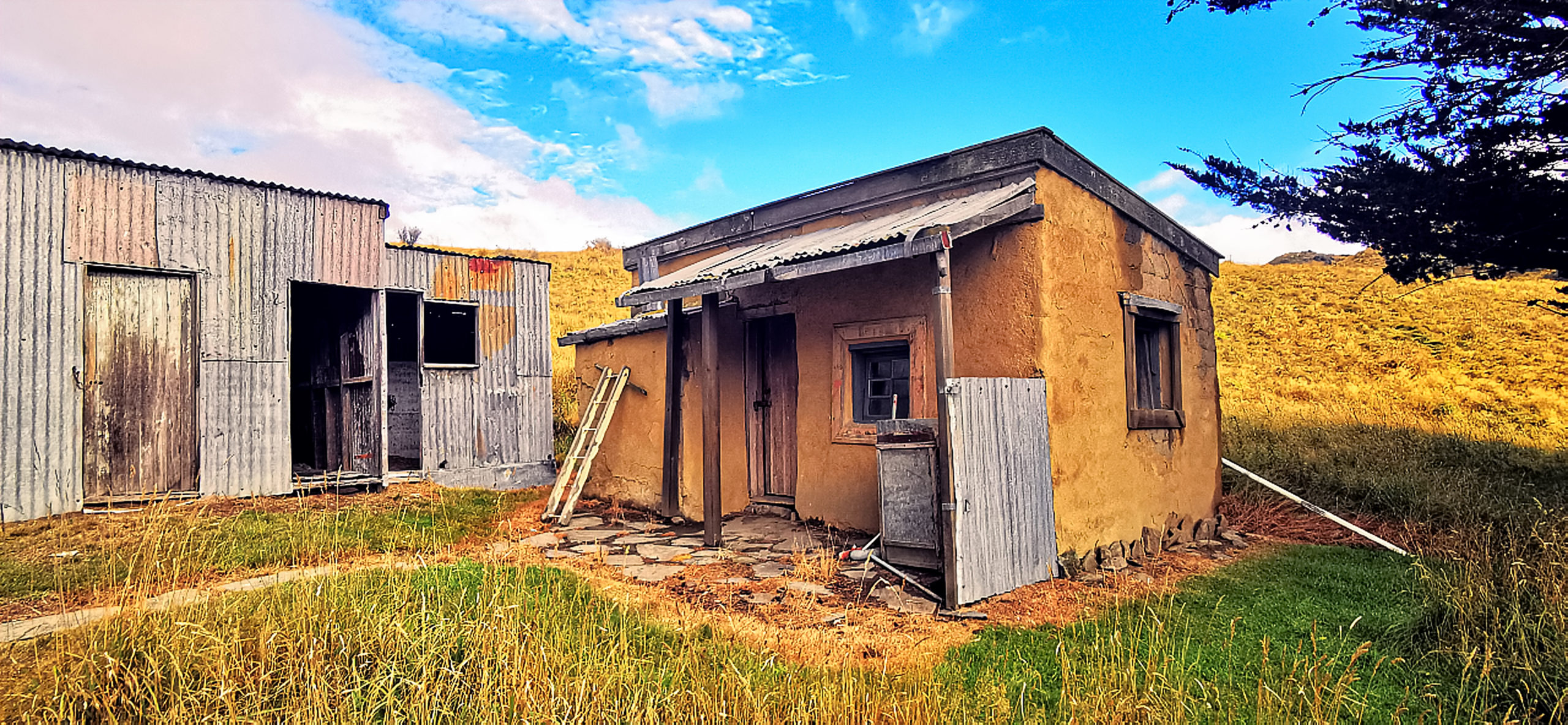
they have stood the test of time
The Donaldson Brothers
The brothers dominated the early years of mining here. They brought their first stamping battery in 1889 and for some years, were the only exporters of Scheelite in the country.
The Donaldson brothers ran the mine until they sold it to a Christchurch syndicate in 1912. They worked the battery until about 1930 then, unfortunately, turned the battery into scrap metal in about 1953.
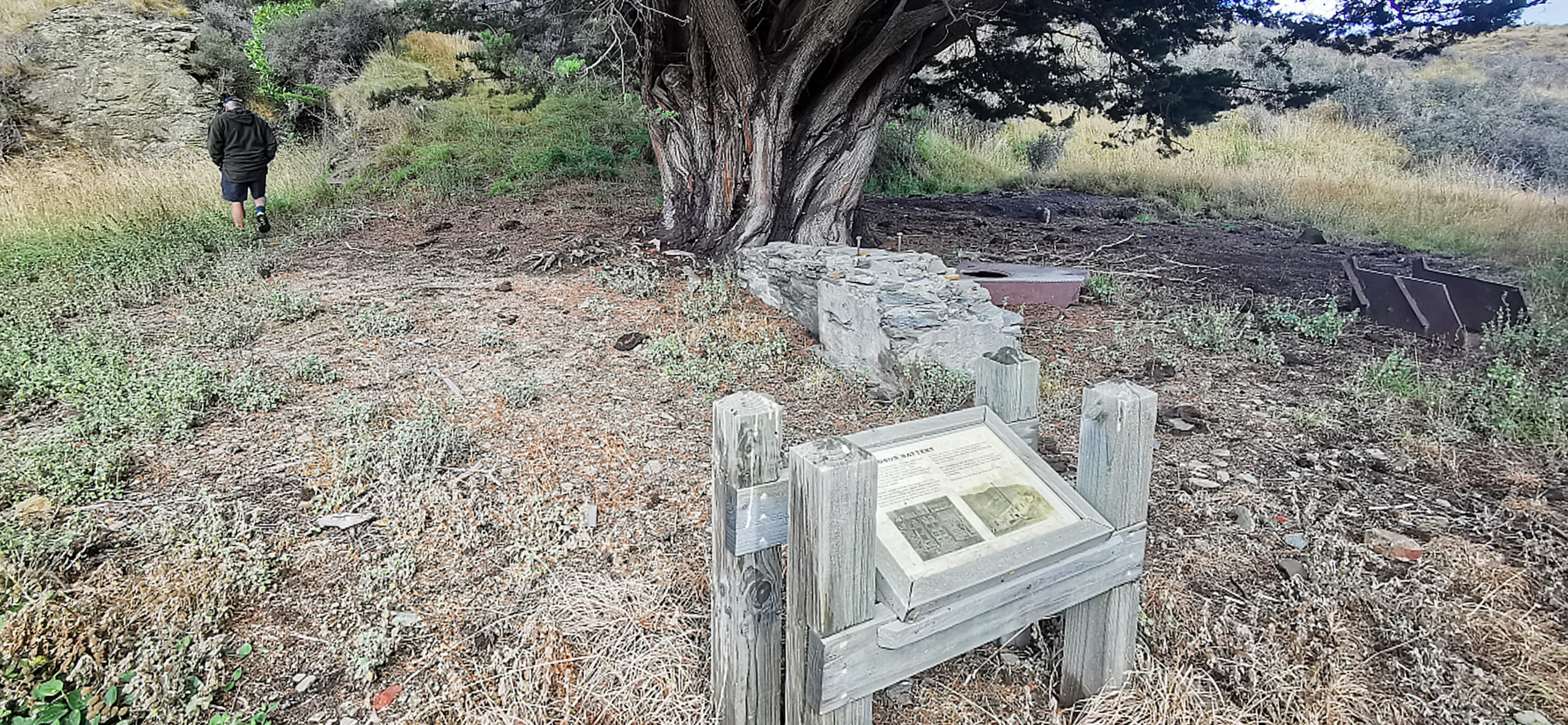
such a shame that the battery was dismantled and sold as scrap metal, leaving behind its foundations
Laying behind the restored cottage lies the only remnants of Donaldson’s battery. Just a concrete foundation and iron bracings can be found amongst the overgrown grass.

some of the old foundations are all that is left of the Donaldson’s Battery
Golden Point Mine
Across a rather fast running and deepish looking river lies the Golden Point Mine. After a few days of rain in the area, it was swift-flowing, muddy and looking rather deep. Nursing a knee injury, I decided against the river crossing. Scotty, on the other hand, shimmied his way along a wire fence, landing dry-footed on the other side.
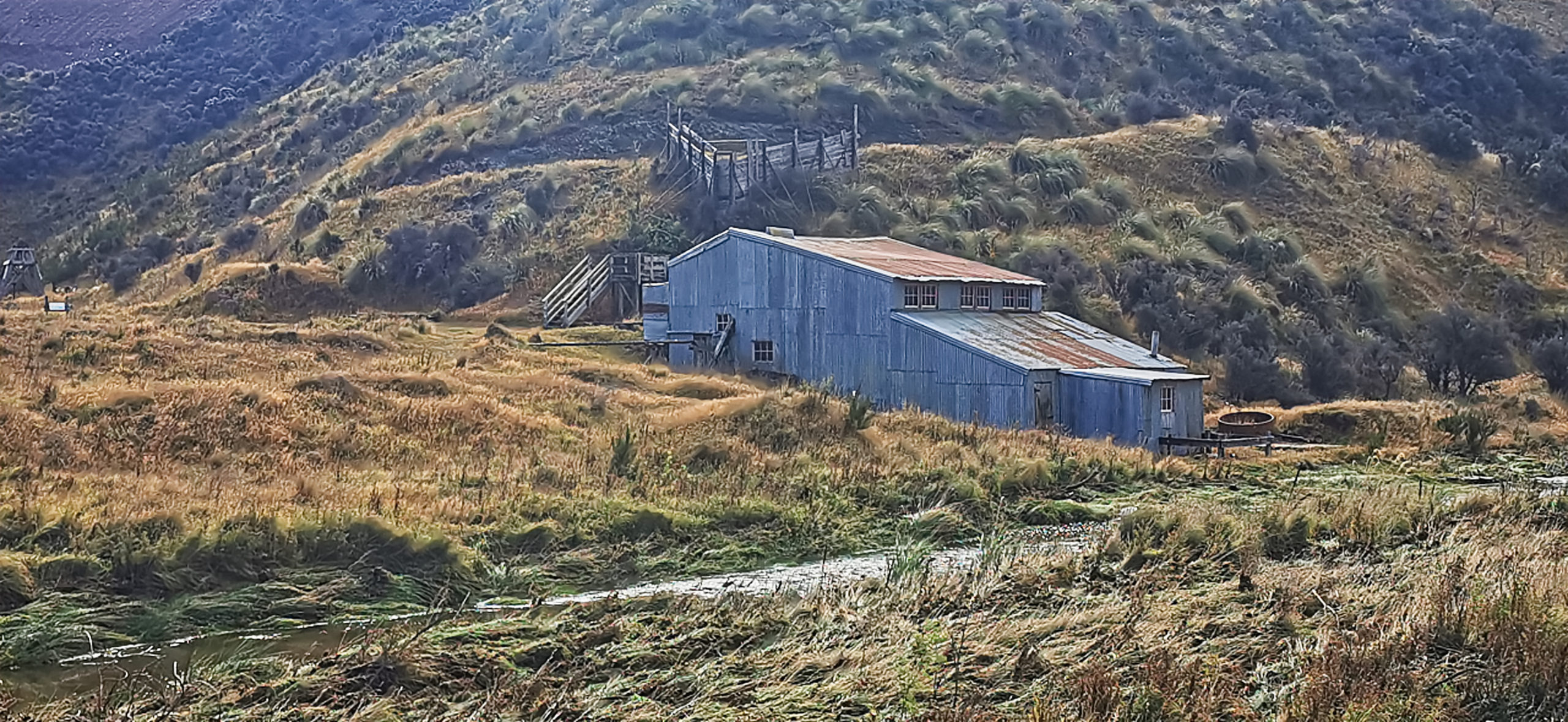
the shedding housing the restored battery and other equipment is located across the stream
I left him to explore the mine site and to take the necessary photos, both inside and outside of the shed.
Located on the opposite of the riverbank is the Callery Battery, Golden Point Battery and Maritana Battery.
Golden Point Battery
Golden Point Battery is the only complete stamper battery in New Zealand to survive on site in working order.
Constructed in 1902 to serve the Golden Point gold mine, the five-stamper plant was in commercial operation until the 1950s and still runs today. DoC starts it up a few times a year. Click here to view a short video of it running.
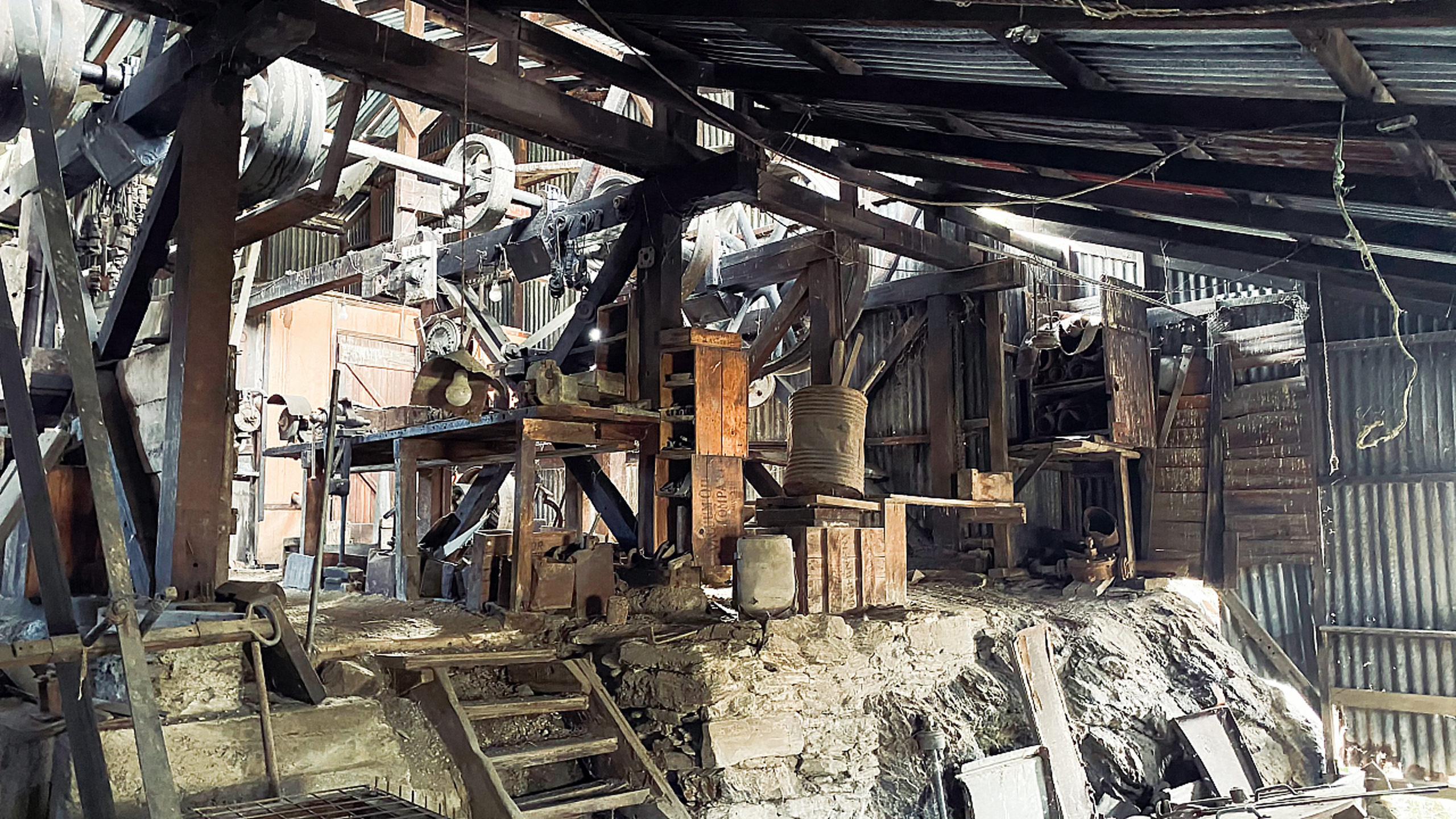
it was a treasure trove inside the shed
All the equipment associated with the mineral extraction process is now enclosed in the adjacent corrugated iron shed along with the battery.
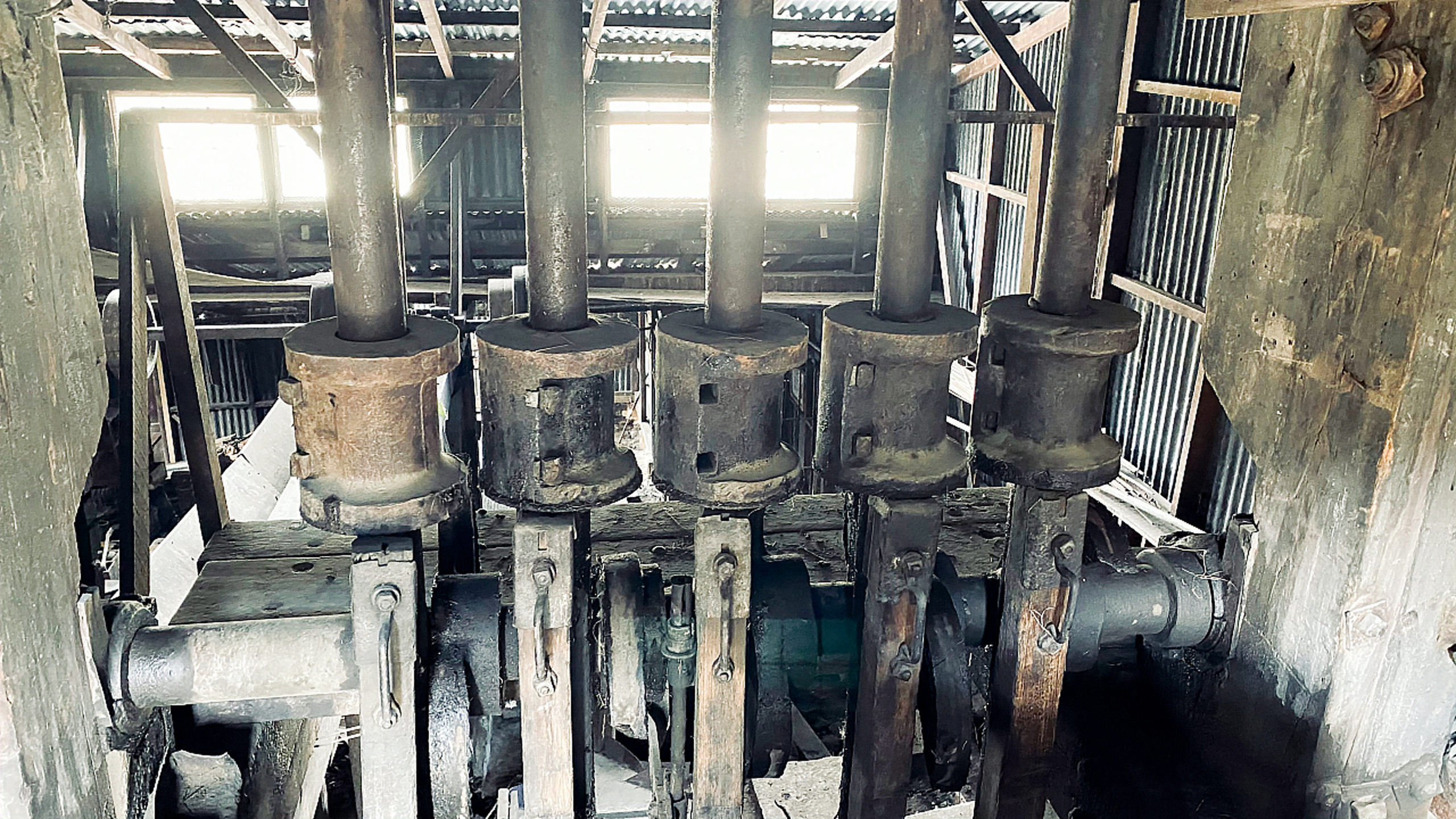
it’s an amazing example of a restored battery still in working order
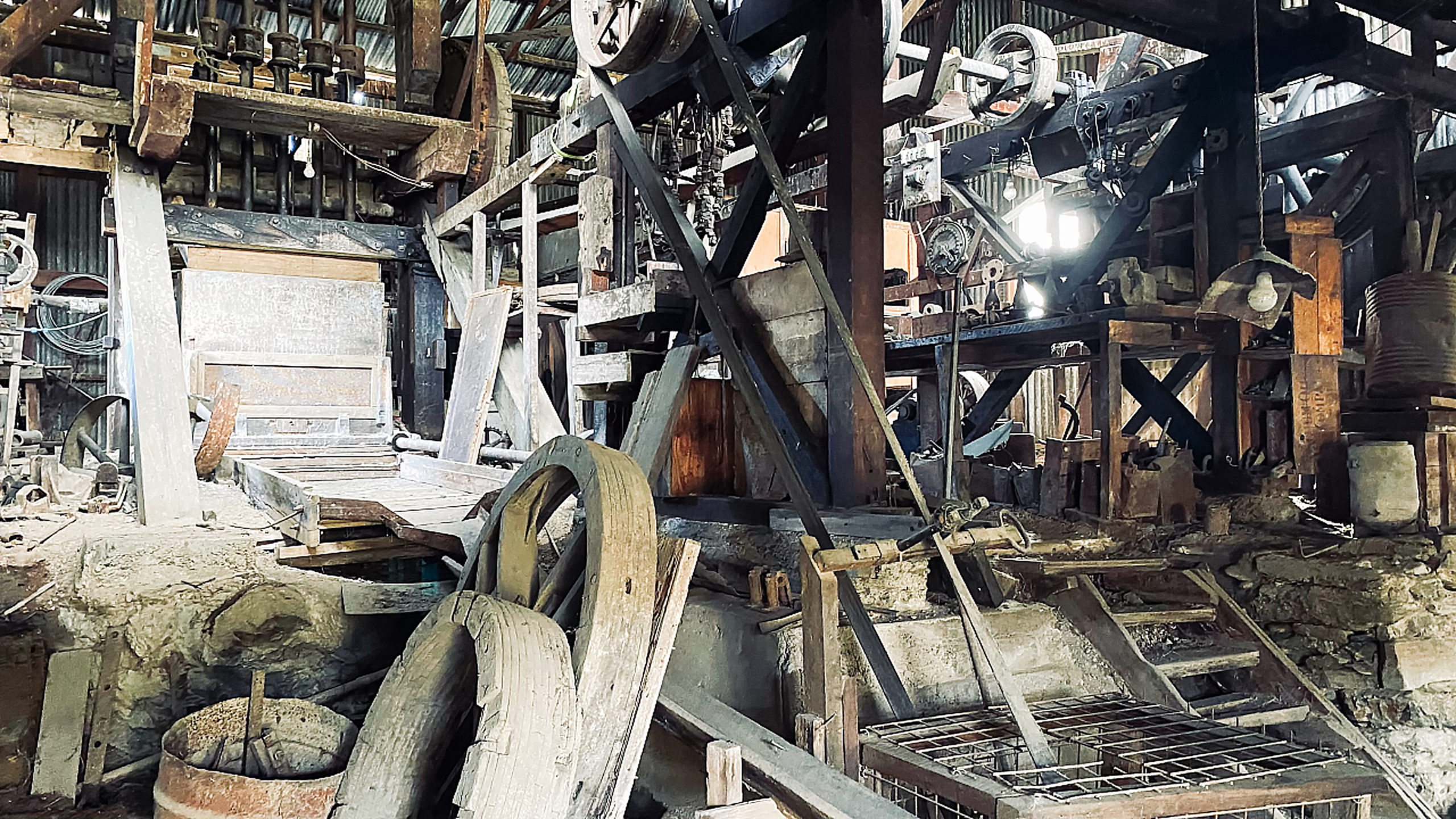
so much packed into the corrugated iron shed
Scotty could still see some remnants of the other batteries which serviced the other mines located in the area. These include Coronation, Deepdell, Golden Point, Round Hill, Innes, Mills, Ounce and Golden Bar.
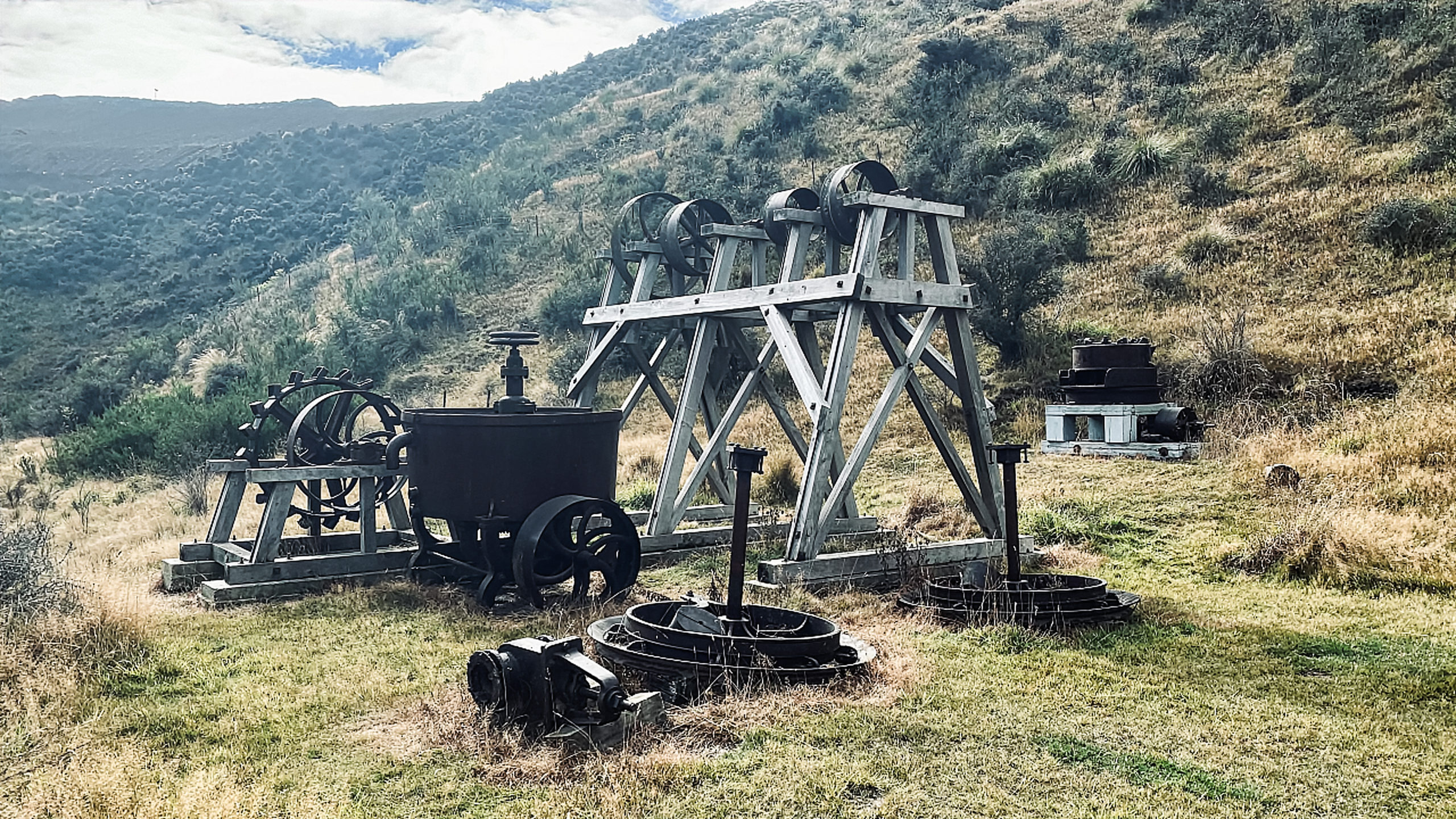
there still some good examples of the other equipment that would have been working hard to smash the rocks to extract the gold
With so many desolate mines dotting the landscape, it would certainly pay you to adhere to the warning signs to keep to the formed tracks. There would be quite a few mine shafts to fall down!
Allow Plenty of Time
Don’t rush your time spent at Macraes Mine or the Golden Point Historic Reserve. Wander the terraces and picture how it must have looked when tents, rock shelters and cob cottages dotted the terrain. Take time to explore the concrete foundations and fallen brick chimney of buildings that sat amongst the tailings on the valley floor.
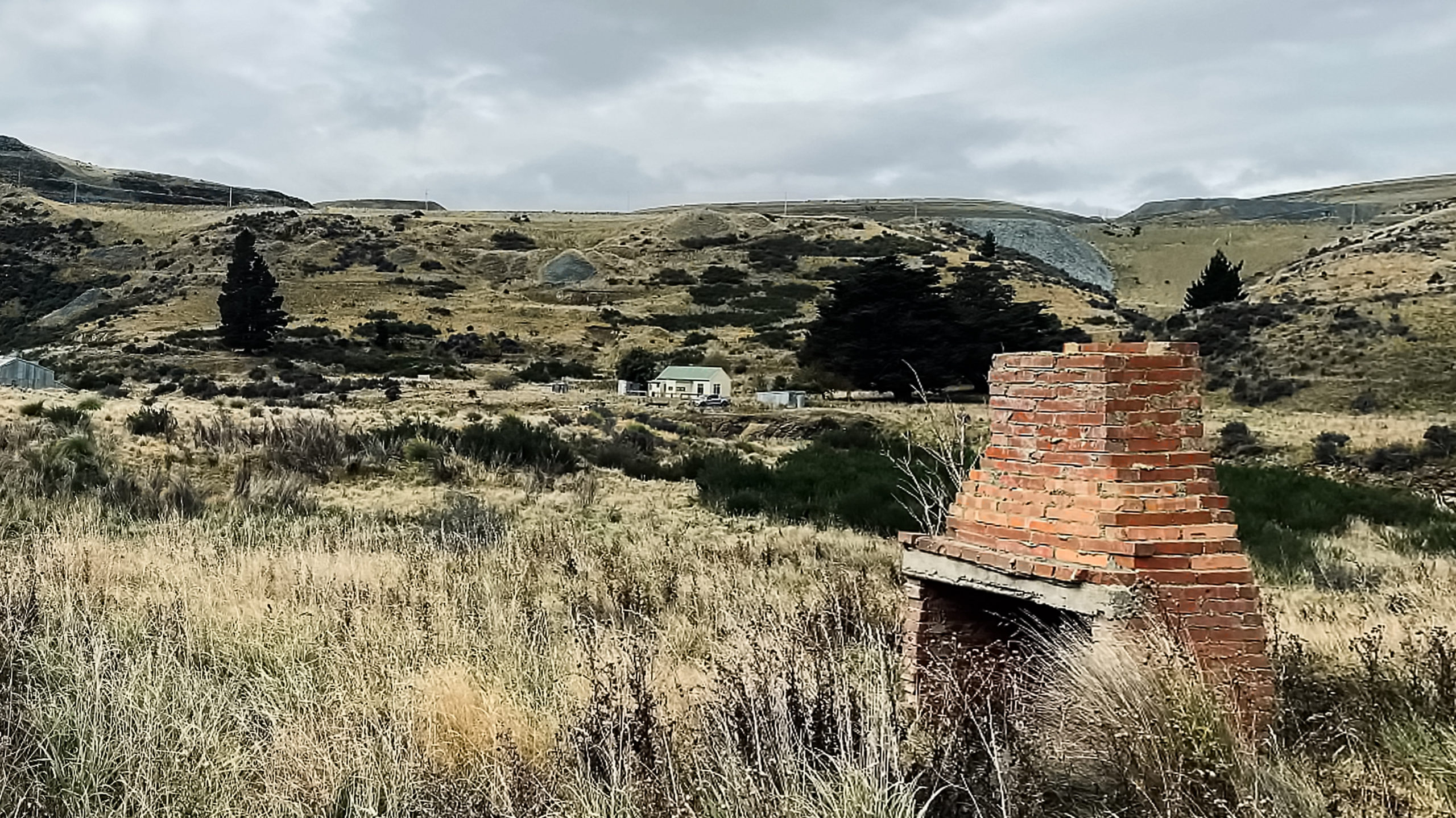
more structures are hidden amongst the overgrown landscape, allow yourself plenty of time to explore
It’s not hard to imagine how difficult life must have been for those early miners.
Macraes Flat
Located a short distance from the huge expansive Macraes Mine site is the small settlement of Macraes Flat township. Named after John McRae who lived in the area from 1859, employed as a shepherd.
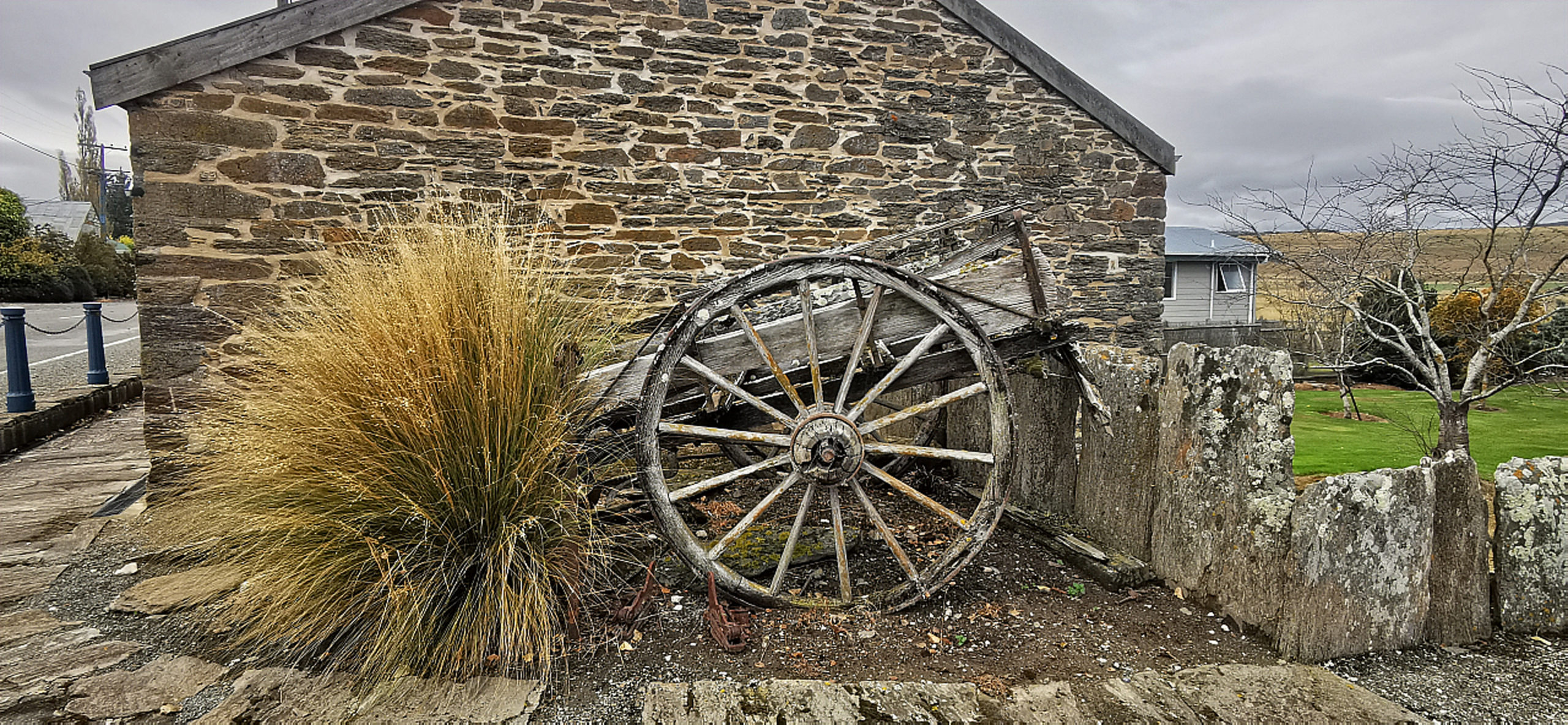
some of the old buildings that make up the township of Macraes Flat
It was once a busy mining town with around 25 businesses and a population of 500 people, it has shrunk quite substantially since the gold mining rush.
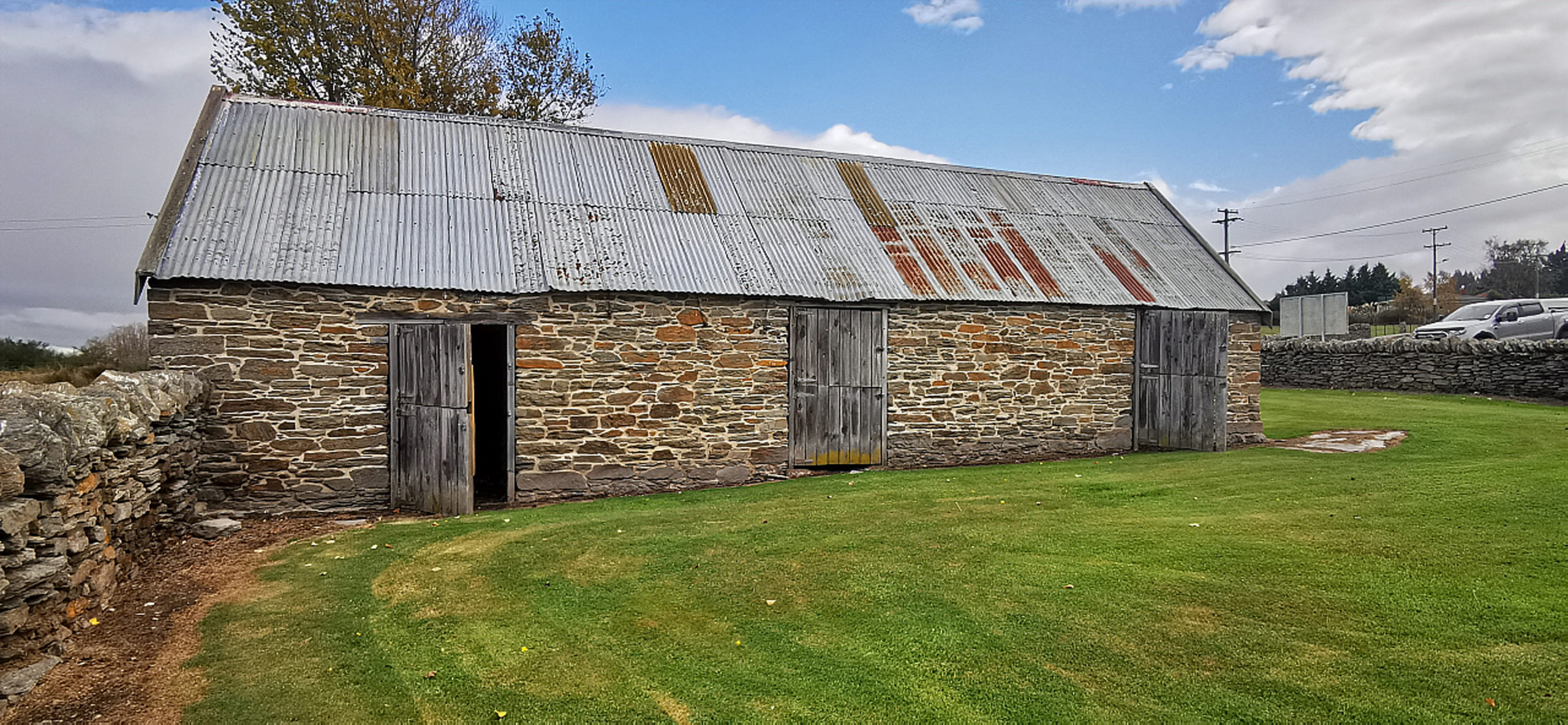
the old stables
We visited the cemetery located on the hill behind the main road through the town. As expected, there were quite a few old graves and many headstones, telling the sad story of the early pioneers in the area.
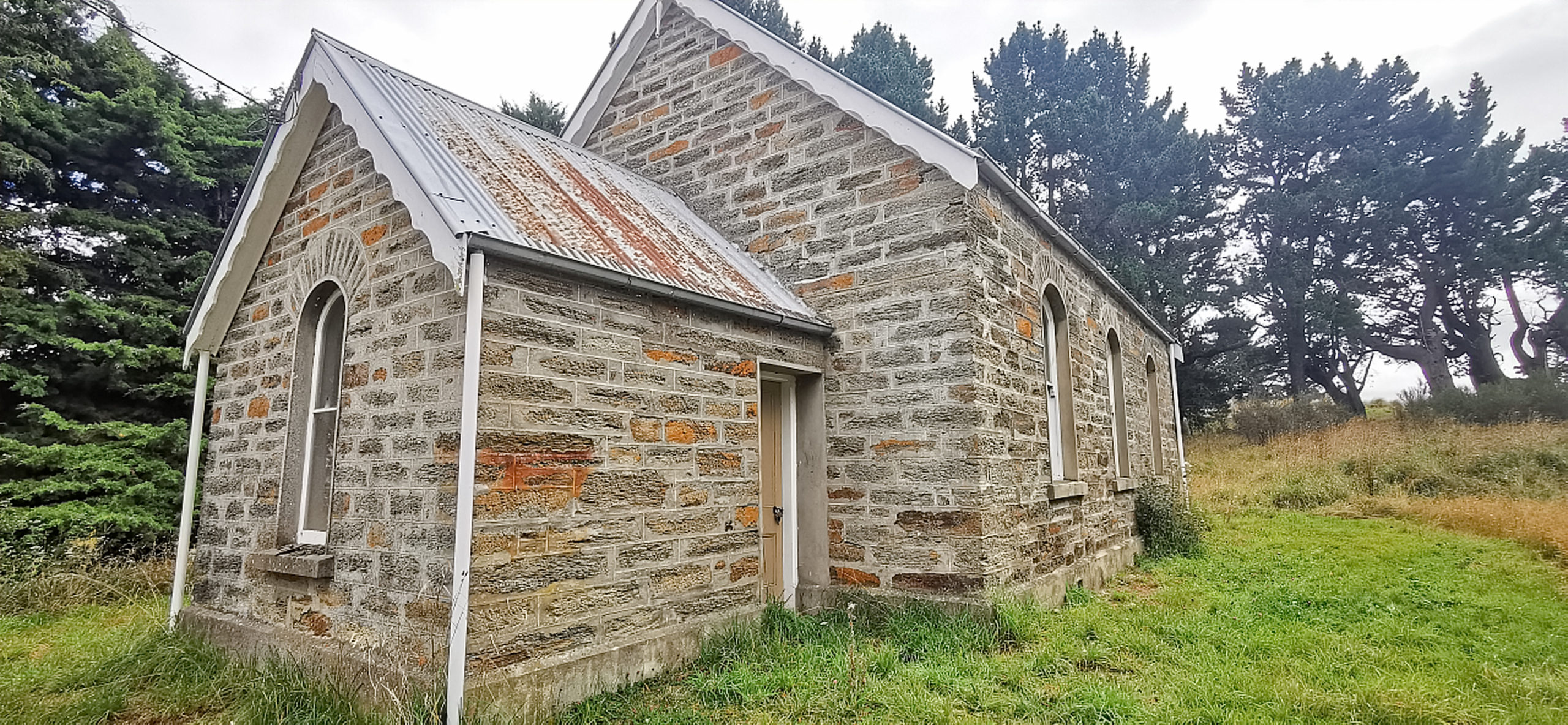
the sweet little schist stone church
The ex-Macraes Presbyterian Church was built in 1906. It was sold by the Palmerston/Dunback Parish in 2014. It still sits just down the hill from the cemetery. There is a scattering of old rusty farming equipment which reflects the industrious farming activity back in the heyday.
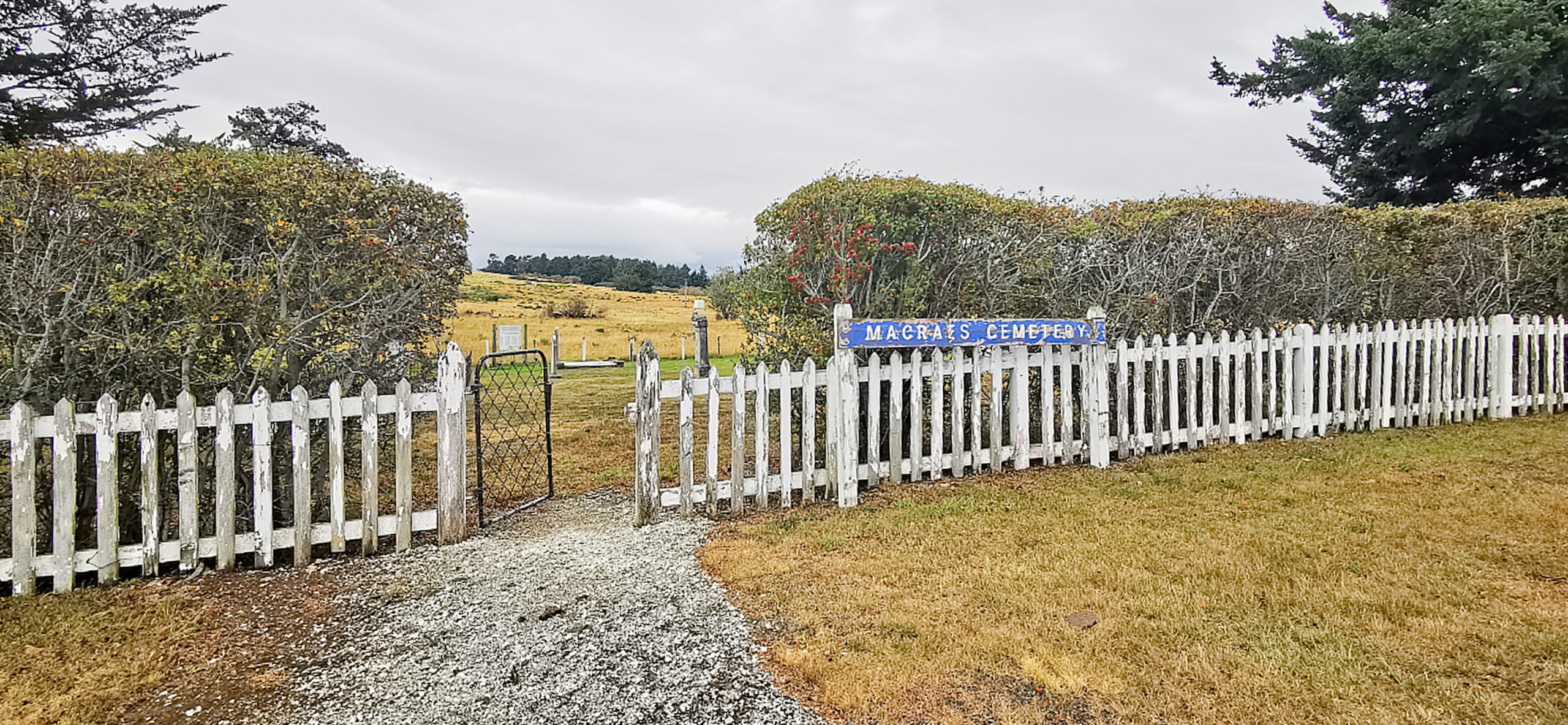
the Macraes Flat Cemetery tells the sad stories of the early residents of the area
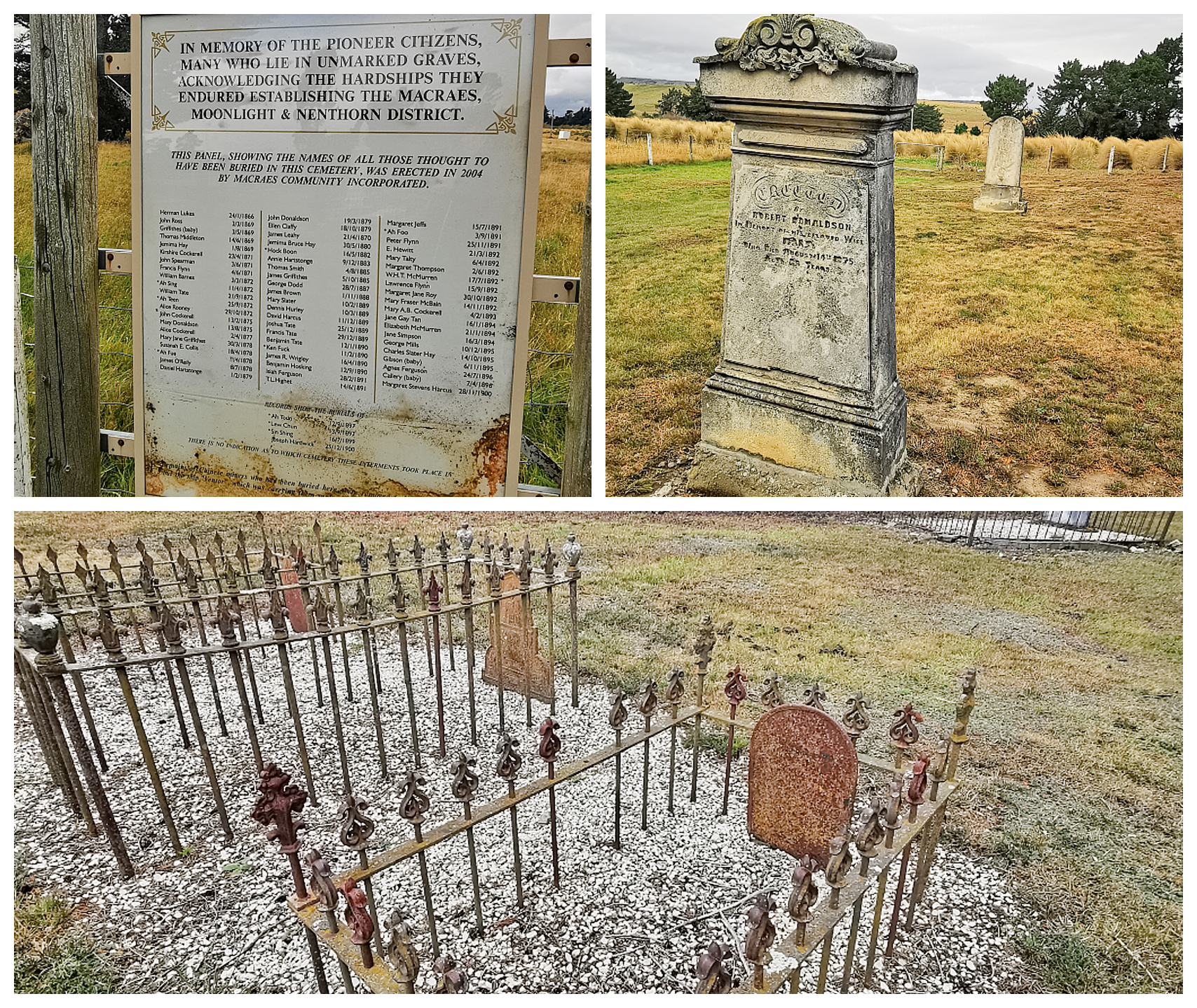
the list of names who are laid to rest in the cemetery and an example of some of the iron headstones
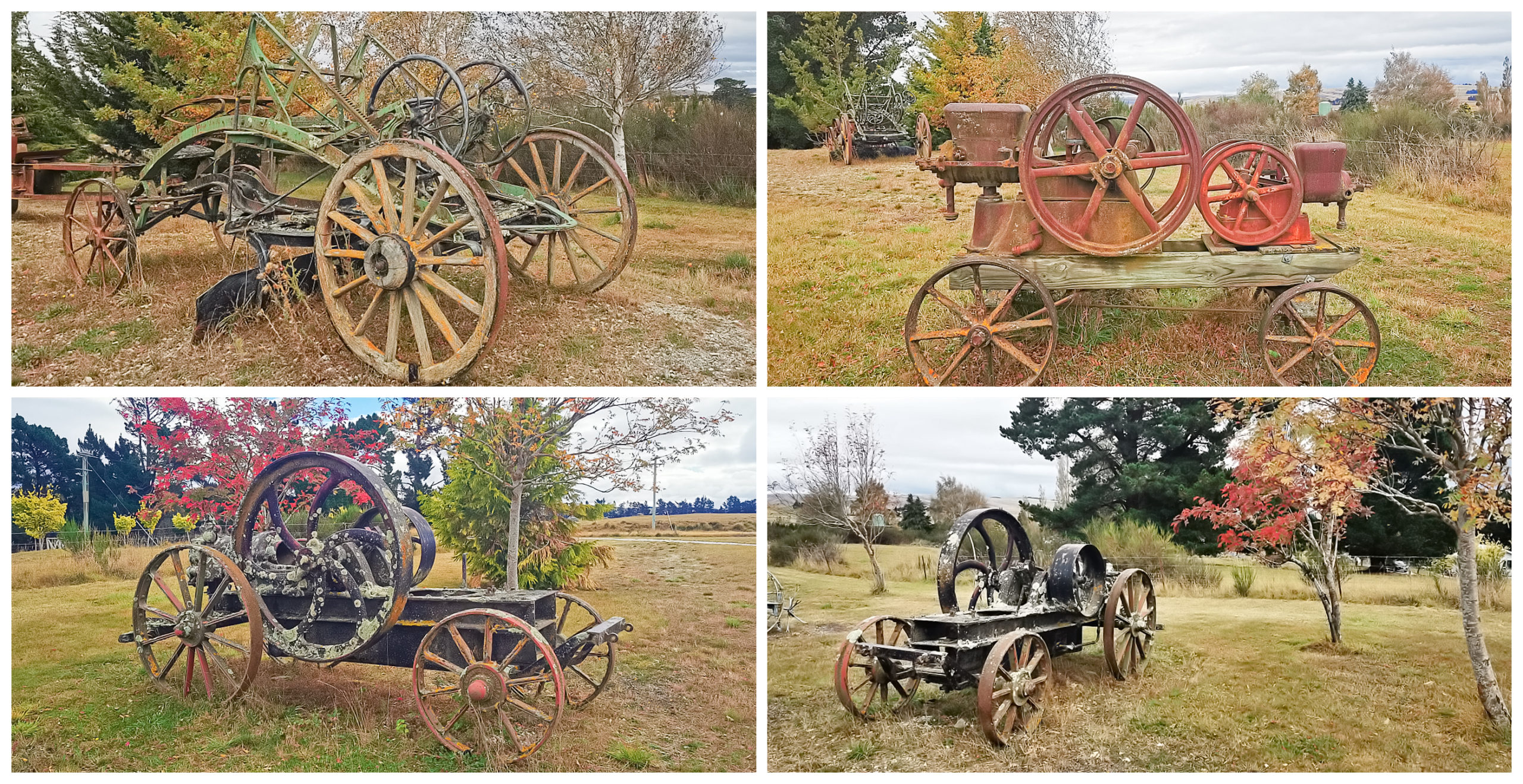
some of the farming relics on the walk down to the old school building
The Stanley’s Hotel
There are still a few old buildings scattered around with the hub of the community being Stanley’s Hotel.
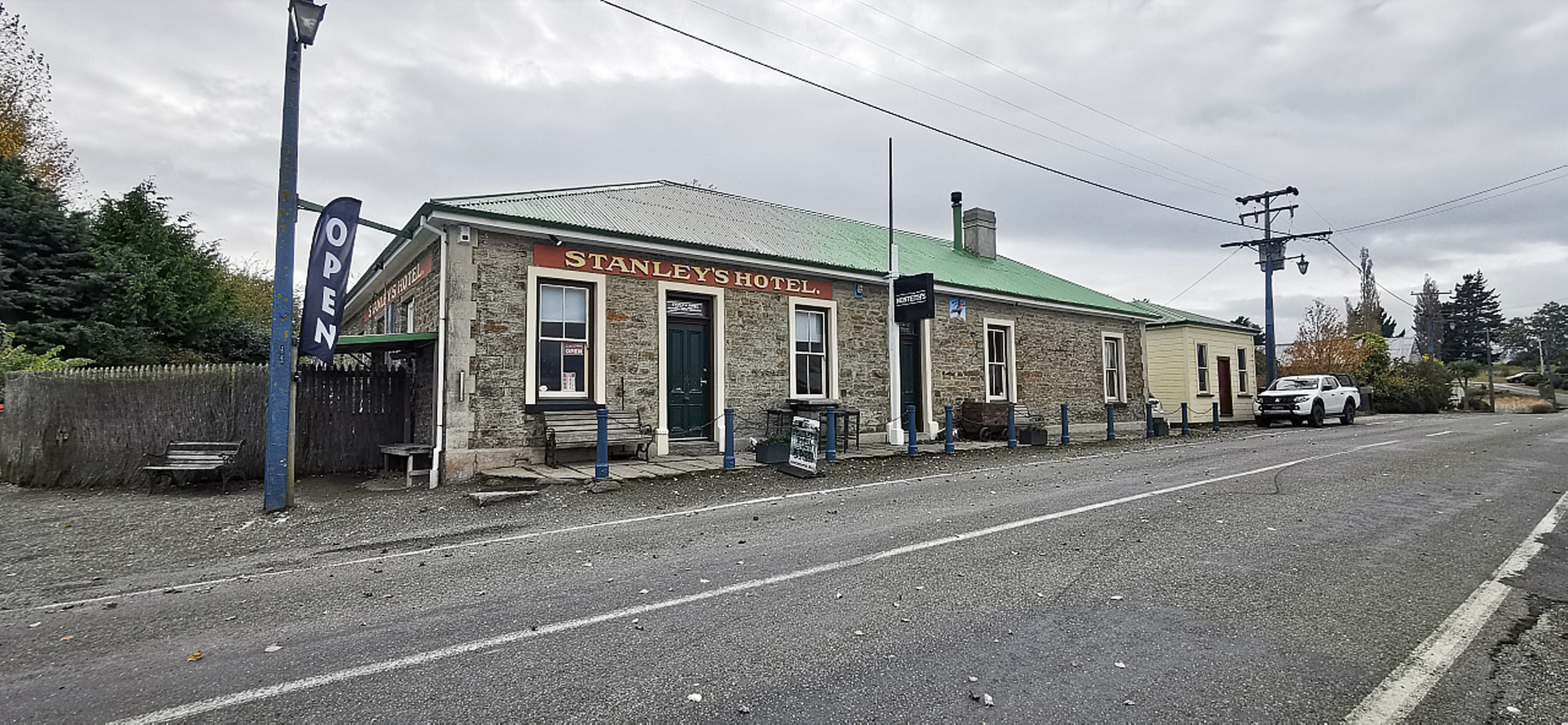
it’s a wonder the hotel is still standing upright seem the stonemason was paid with ale!
The single-story stone hotel was built back in 1882 for owner Thomas Stanley. I thought it was interesting that it remained in the Stanley family until 1960. That’s a very impressive period of time of single-family ownership.
Towards the rear of the building, there is still evidence of a billiards room, stone shed, stables and pigpen.
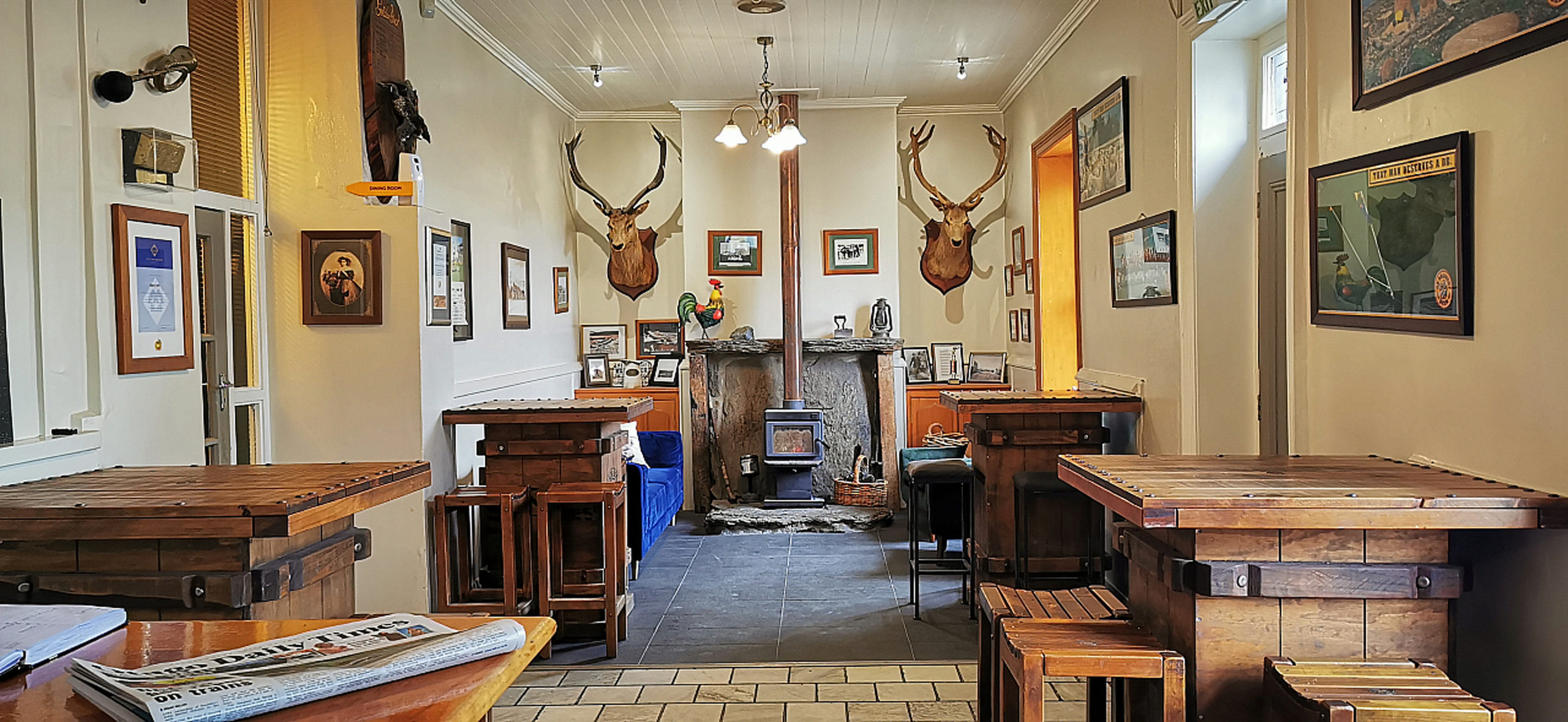
the inside of the bar area is snug and cosy with a fireplace roaring in the far end
The structure shows a great example of the work of a nineteenth-century stonemason. He was paid in ‘ale’ which may explain some of the crooked walls.
We stopped off for a couple of cold refreshments and to take in the ambience of the historic pub.
Wetland Heritage Walkway
Across the road from Stanley’s Hotel is the Macraes Wetland Heritage Walkway. Its centrepiece is a 7.5-metre steel Haast Eagle. The 750kg piece was first flown by helicopter from the Arrowtown home of sculptor Mark Hill to a site above Macraes in 2008. It was later relocated to the wetland area which forms part of the Heritage Park.
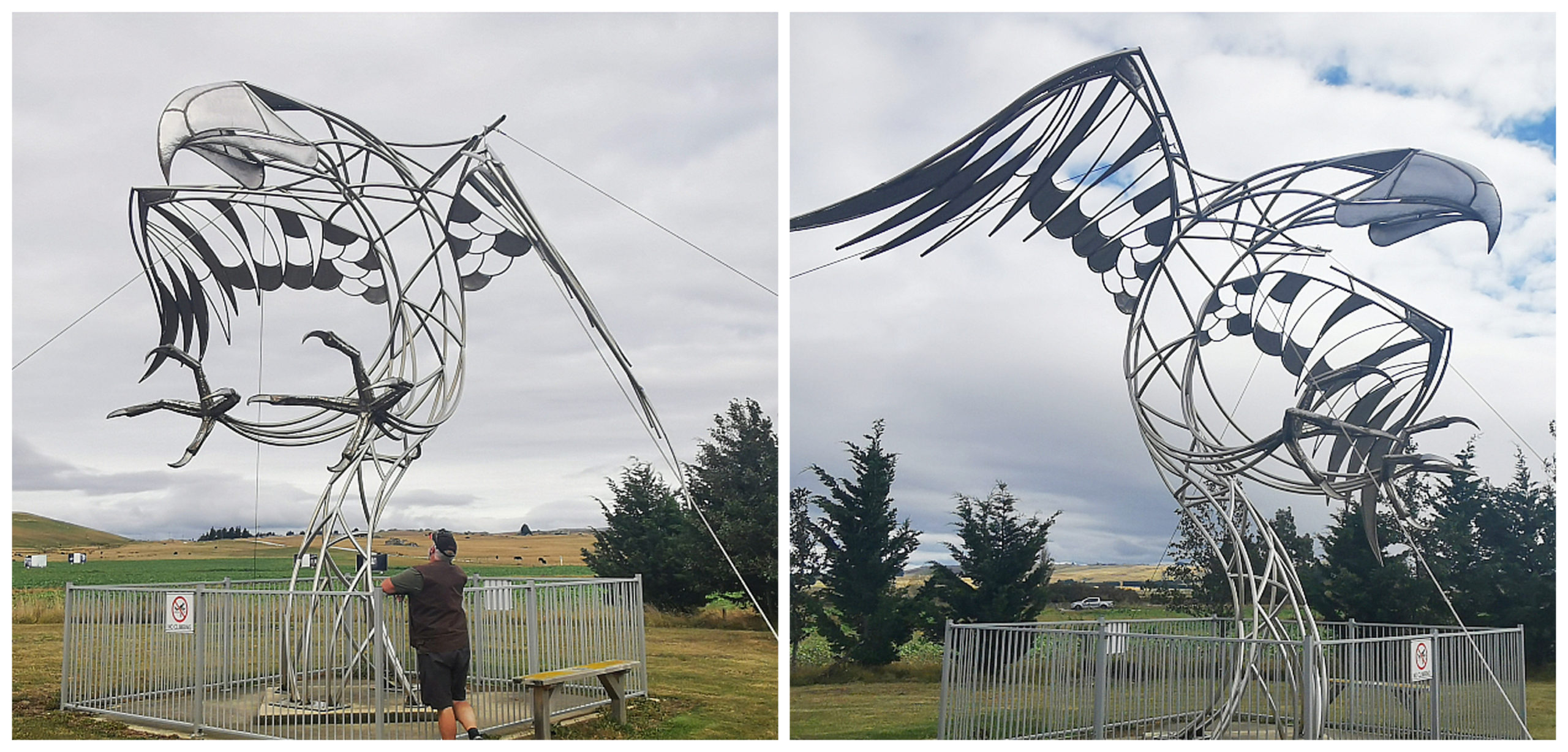
it is quite an impressive art installation
We spotted some of the random billboards placed in a paddock further along from the wetlands. Although we didn’t make the trek through the grassy paddock, we could see that they are starting to show the test of time. The weather hasn’t been kind to some of the structures.
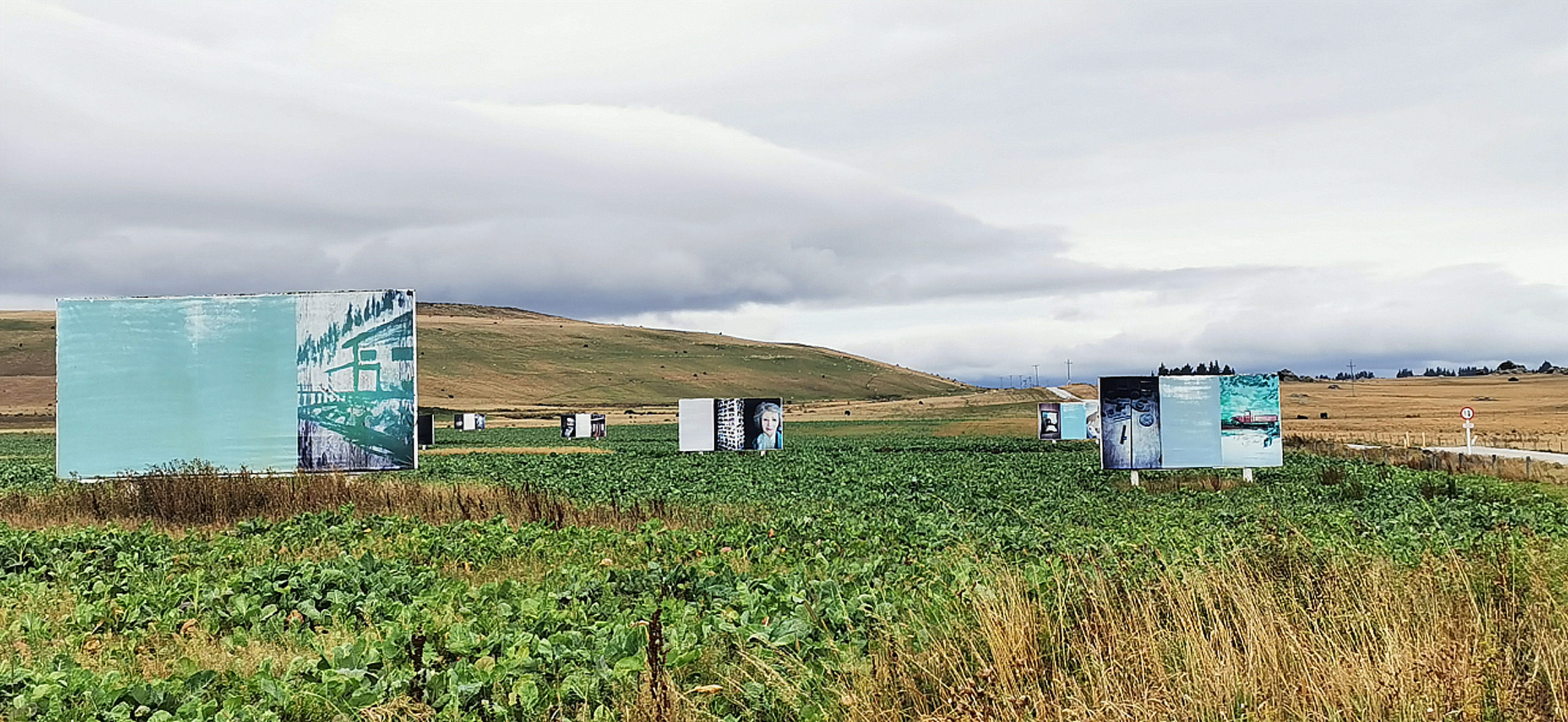
the scattered billboards through the neighbouring paddock
Macraes – Past, Present and Future has now been ticked off our list.
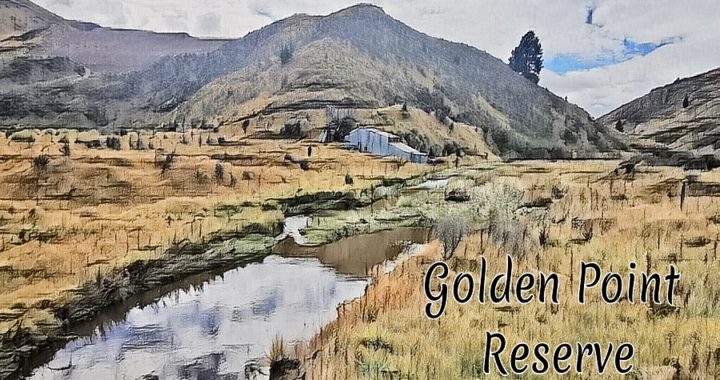
I have driven the road & stopped for a cold one at Stanley’s on occasions but never visited the mine. Thank you for your coverage of the area. I now feel as though I have.
It’s always important to keep hydrated on these roadies too. ☺️. Stanley’s is a great old pub with loads of character. Glad you enjoyed the read.
Some years ago we did a tour to Macreas from Dunedin, by train, then mini bus and a trip to the gold mine. It was quite a day, with lunch included. Not sure if the tours are still operating or not.
I don’t think the tours are operating – the public lookout is also gone as they are mining through that area now too. Such an interesting place to explore though.
The hotel had around 300K spent on it by the Mine, and brought it up and beyound earthquake standards…
oh interesting, didn’t know that. So glad it is still operating and open to the public.